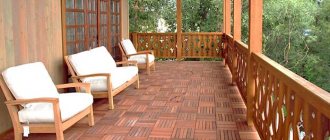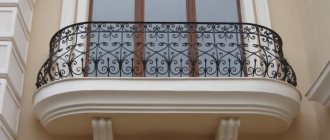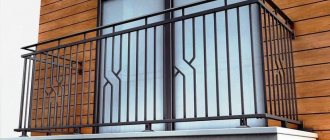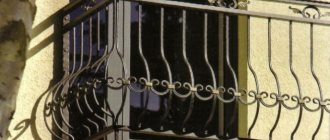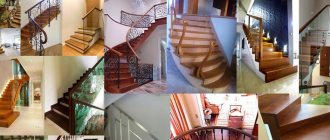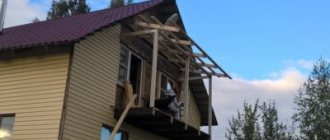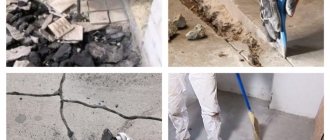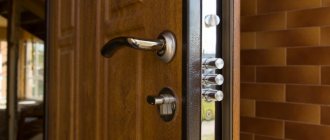Everyone knows what a balcony is and why it is needed. Also, everyone knows that balconies are different.
During the Soviet years, two models were mainly practiced:
- on standard runs;
- on a reinforced concrete base.
The first option involves mounting on powerful reinforced concrete or metal beams that go half a meter deep into the wall. In the second option, the structure supporting the platform is a reinforced concrete slab.
Recently, balcony architectural forms have diversified. Balconies appeared:
- with external supports;
- mounted;
- attachments, etc.
Despite all this variety of balcony forms, there are basic elements of their designs, and amateur activities in their construction are not allowed, since this is related to the safety of people. GOST and SNiP (building codes and regulations) strictly regulate all parameters related to the construction and operation of balconies. One such safety element for balconies is railings.
SNiP interprets the very concept of a balcony as a fenced area. People who are engaged in private construction, for example, building a country house or a country house with a balcony, try to find in various sources the answer to the question - at what height are the railings on the balcony made? Although the wording of the question itself is somewhat imprecise. You should ask a little differently - what should be the minimum height of the railings on the balcony according to building regulations? Since they are subject to strict requirements for vertical dimensions and design features.
Balcony railings must comply with the requirements of GOST and SNiP
Requirements of regulatory documents for fencing balconies
The main function of balcony railings is to ensure the safety of a person standing on the balcony. Strict requirements are set out in regulatory documents. “Building codes and regulations” and GOSTs regulate, in particular, the level of load on the railing and the height of the fence. Thus, according to SNiP 2.02.07, the balcony fencing must withstand an applied load of at least 100 kg per 1 rm.
The height of the balcony fencing according to GOST 25772-83 depends on the total height of the building:
- in a building up to 30 m, the height of the fence is 100 cm;
- in a building above 30 m -110 cm;
- the width between the vertical posts is no more than 10 - 12 cm;
- Standards do not allow the use of horizontal lintels in railings.
These rules are prescribed for multi-storey buildings. In preschool institutions, the height of the balcony railing is in any case at least 1.2 m. In individual construction, these requirements are not always met, because all the details are not taken into account in the sources defining the rules.
Panoramic glazing of the balcony
Furnishing a room with panoramic glazing is a popular solution, tempting with many prospects: good lighting, maximum viewing angles, visually increasing the room space. On a balcony with panoramic glazing, the fencing function is performed by the window frame, so questions related to the construction of a traditional parapet disappear.
But this does not mean simplifying the arrangement procedure - panoramic glazing qualifies as reconstruction of an apartment and is carried out only after agreement with local authorities.
Types of balcony fencing by design features
According to their design features, fencing is proposed to be divided into the following categories:
- Screen . They are a solid sheet of plastic, glass or metal, which is attached to vertical supports. According to GOST, it is recommended to use only such fences for balconies of multi-storey residential buildings, with the exception of balconies of smoke-free stairwells;
- Lattice . Elements are used in the form of a lattice, with a parallel arrangement relative to each other, or in the form of a fantasy random ornament;
- Combined . Popular type of designs. You can also combine different types of materials.
The system of screen and combined fencing must contain elements that will ensure trouble-free replacement of screens.
GOST dimensions: balcony slabs
Parameters, sizes, types of balcony slabs are regulated according to GOST 25697-83. The slabs themselves are divided into several types: PB - solid flat beams, PBK - solid cantilever flat, PBR - cantilever ribbed. The length of balcony slabs is from 1200 mm to 7200 mm, the width of balcony slabs is 1200-1800 mm.
Related article: Requirements for balconies of apartment buildings
The thickness of typical balcony slabs in a brick house or panel house is in the range from 150 mm to 220 mm. It all depends on the type of slab, the dimensions of the slab and the weight of the slab.
It is possible to expand the balcony structure along the base of the slab. This concept involves providing additional usable space. But first, the loads of the balcony structure on the same slab are calculated to prevent its collapse. Typically, metal or steel brackets are used to expand the balcony.
Classification of balcony railings by type of material
Balcony railings are structures that have a protective function. In addition, they are important details of the building facade. The materials used for the production of railings must be reliable, strong enough and invulnerable to atmospheric influences and temperature changes.
When constructing fencing, the following materials are used:
- stainless steel and ferrous metal;
- forged metal;
- plastic or tempered glass;
- stone, brick, concrete;
- tree.
Stainless steel and ferrous metal fencing
Balcony railings, made of stainless steel, are comfortable, beautiful, and practical. The configuration of parts can be varied - with straight or curved outlines. “Stainless steel” looks great in company with other materials - glass, concrete, metal. This allows you to create interesting and stylish combinations when decorating facades.
Stainless steel railings are absolutely not afraid of aggressive natural influences, they are durable and have a long service life. For their installation, argon arc welding is used. The design does not require additional finishing, but can be painted if desired.
Ferrous metal is also often used to make railings. If desired, the finished structure can be painted in any color with metal paints, or powder coating can be used. The height of balcony railings is at least 1 m.
Wrought iron railings
Designers love to use forged metal when finishing facades and interiors. Forged parapets have a variety of configurations and bizarre shapes. They are easy to install, create a feeling of lightness and airiness, and can be combined with any style of architecture. This is not just an exquisite design solution, but a work of art with artistic value. Good craftsmen are creative in making products.
Each fence has a specific architectural style:
- Gothic – trefoil and four-petalled rosette.
- Byzantine style - ornate floral patterns.
- Renaissance - spiraling vines with clusters and buds.
- Baroque - lots of curls around flower baskets.
- Rococo - asymmetry combined with floral fragments.
The fashion trend of recent years is combining and mixing different styles. Forged fences will not protect from wind, dust and rain. But it is simply beautiful, elegant and aristocratic. They go well with buildings in the old quarters of historical city centers. Such designs can be seen on the facades of respectable country houses. The height of the railings on this type of balcony is at least 105 cm.
Such fences have one, but significant drawback - susceptibility to corrosion. Treatment with special protective compounds will help to cope with this problem.
Fencing made of plastic and glass
The advantages of plastic structures are their relatively low weight, low price, availability and attractive design. Glass parts must be made of tempered glass, at least 3 mm thick. The height of the fence on the balcony is at least 100 cm. The design looks creative and fashionable, and, despite its external fragility, it is stable and durable. Both solid canvases and in combination with metal elements are used.
Glass fencing protects from city noise, easily withstands aggressive weather conditions and high wind loads, without losing its decent appearance and properties. They are characterized by a long period of operation. If necessary, they can be easily dismantled and moved to a new location. They are low maintenance and do not require constant treatment.
Glass fencing is a modern option for organizing space inside a balcony or loggia.
Fences made of stone, concrete or brick
When choosing such a fence, you need to make sure that the ceiling can withstand heavy loads, since the railings will be massive and heavy. In addition, they take up a lot of space. The work uses natural and sometimes artificial stone made from sand, cement and granite chips. Concrete balusters and brick parapets look solid and solid.
If you plan to build a brick fence on the balcony, you must obtain permission from the relevant authorities.
Balcony railings are mostly made of brick, concrete or aerated concrete blocks. This is a reliable, durable and durable structure.
Wooden railings
Wood is not the most practical material, as it is susceptible to negative atmospheric aggressions and rotting. It is familiar and quite easy to work with. Connoisseurs of wood use it mostly for interior decoration and decoration. However, owners of private houses prefer stylish and beautiful designs of balconies and terraces made of wood. Such structures look very harmonious in southern cities.
A wooden parapet is made by combining vertical and horizontal fragments. The height of the railings on the balcony is made in accordance with the standards. Such fences must be reinforced with metal fasteners. To protect wooden structures from dampness and rotting, it is necessary to use special means. Treatment must be repeated at least once a year.
The height of the balcony to the window - what should it be?
When converting a balcony area into a room, not only the parameters of the environment in contact with it change, but also the geometry of the existing enclosing structures - after insulation from the inside they become thicker, which entails other changes.
From the perspective of compliance with safety requirements, we will consider one of such structures - a balcony fencing, or how to equip a balcony area so that the characteristics of the parapet comply with established standards.
Railing installation methods
When installing balcony railings, different methods are used, depending on the type of fencing:
- Fences made of metal and stainless steel are attached to embedded parts. These are small metal elements that are pre-fixed in balcony slabs, brick and concrete walls. If the slab is a metal structure, then the embedded parts are installed only in the walls, and the fence posts are attached to the slab by welding.
- Wooden railings are installed by attaching them to wooden load-bearing elements with self-tapping screws, studs or other hardware.
- Stone and brick parapets also need to be tied to the wall. This is done in any convenient way, for example, using embedded parts embedded in the wall.
- Parts made of plastic and tempered glass are attached to the metal frame using bolts and rivets.
- The height of the balcony fencing must in all cases comply with the specified standards.
When carrying out construction and installation work on the installation of balcony railings, it is necessary to comply with safety regulations. Violation may result in a fine or a complaint from neighbors to regulatory authorities.
When performing this work in an urban environment, it is necessary to fence off the dangerous area so that nothing can fall on the heads of people passing below, and put up warning signs or plates.
Very often, such work must be agreed upon with the management company. Sometimes the consent of the general meeting of residents of the house is even required.
Types of enclosing structures
The following types of fencing are used:
- Forged, the cost of which is significantly higher than the price of other balcony design options;
- Wooden, their attractive appearance is achieved through the installation of carved railings and balusters. Thanks to a well-chosen combination of horizontal and vertical structural elements, sophistication is achieved in the design of fencing for balconies and loggias.
- In the form of a brick or concrete parapet, providing a reliable base for installing frames made of metal-plastic, wood, aluminum;
- In the form of screens made of durable plastic or glass.
To connect all elements of various types of balcony railings, special fasteners or welding are used.
Aesthetic and functional requirements for balcony railings
The main task of fencing is to ensure complete safety of people on the balcony or terrace. The metal frame must support the weight of an adult. But in addition to performing this important function, the railings must fit harmoniously into the facade of the building and be aesthetically pleasing. The ideal design of the railing determines the overall appearance and style of the balcony.
When designing and building a country house, you can bring various interesting ideas to life. For example, build a terrace around the entire perimeter of the building, or give it a non-standard shape. When choosing a material for fencing, you need to be guided by the general style of the building’s facade, so that the balcony does not look like an alien element. For example, stone railings on a wooden facade would be inappropriate.
The railings must fulfill the required conditions as much as possible. The height of the balcony fencing is at least 1.1 m, and if there are children in the house, then preferably at least 1.2 m. The distance between individual vertical elements should be no more than 12 cm.
There are also requirements for the handrail - it must be perfectly smooth so as not to cause damage to your hands.
Other requirements
There are other rules that should not be broken in order to be safe when going out onto the balcony.
- The entire site must withstand a load of 200 kilograms per square meter. The proper design load is doubled at the point where the fence is attached, since there is a possibility that a group of people will simultaneously stand leaning on it.
- Handrails are made in such a way that they can withstand a load of 30 kg/sq.m. in the horizontal direction. m, in vertical – 100kg/sq.m. Such strength will make it impossible for them to shift or deform when people lean on them.
- The material for the railings should be selected based on its resistance to:
- open fire;
- temperature changes;
- water;
- chemically active substances;
- mechanical loads.
These conditions are best met by stainless steel, forged metal, stone, and special glass.
- When designing a balcony on the wall of a private house outside the city, for example, in a country house, one should not forget that the slope from the wall to the fence must be at least two percent so that water does not collect and the structure does not collapse.
- It is necessary to provide the required width of the wall. This is the unglazed part of the wall behind which you can hide from fire in the event of a fire. Its width should be 120 centimeters.
Balcony fencing made of marble will satisfy the taste of any esthete
Criteria for choosing railings for a private house
In urban construction, residential buildings are built mainly according to standard designs, following proven standard solutions. In individual construction, the developer has the opportunity to order designers to develop any projects that satisfy his needs and preferences.
There are some important points to consider:
- Safety . Railings should protect a person from sudden external threats and from falling. The height of the balcony railing should not allow an adult to easily lean over the parapet.
- Durability . When choosing a design, you need to pay special attention to the strength characteristics of future structures.
- Aesthetics . The fence should not stand out from the overall picture and be a dissonance against the background of the rest of the building’s design.
- Resistance to wind loads . This indicator is very important when using screens made of plastic and glass with large windage.
- Durability . The design must withstand any weather and atmospheric negativity.
Requirements depending on the type of premises
Kindergartens and other preschool institutions
Stair railings in these institutions are installed at a height of 50 cm. If there is a large flow of visitors, an additional handrail for adults is installed at a height of 90 cm.
For preschool institutions, there is a standard that determines the distance between the vertical posts of the fence. The gap between the balusters should not exceed 15 cm.
Schools
In schools, at the request of GOST, fences with a height of 120 cm or more are installed. This requirement is due to the need to restrain the child from accidentally falling. The activity of younger schoolchildren during recess is quite high, so such a high barrier to the opening is required for safety.
For special schools and educational institutions for mentally retarded children, stair railings are made of metal mesh at a height of 1.5 to 1.8 m.
Fire escapes
All buildings whose height exceeds one floor are equipped with these structures. The guardrails of fire escape and escape stairs at the exit site should be 120 cm.
Outdoor installation sites
This design provides for the installation of fencing with a height of 100 cm.
In addition to the listed requirements for the height of fences, there are standards regulating the width of the railings (from 30 to 70 mm) and the distance between the vertical posts (no more than 50 cm).
How to strengthen a balcony parapet
If the fence has aged and began to collapse, it is necessary to take measures to strengthen its structure. If you plan to glaze the balcony in the future, you must take into account that the increased load on the existing parapet can damage it, and then the new glazing will also suffer.
Primary requirements
It is necessary to assess the technical condition of the existing balcony slab. But for this you need a conclusion from the management company’s commission. It is not recommended to make decisions on rebuilding the balcony parapet on your own.
The height of the balcony fencing according to GOST 25772-83 ranges from 1 m (in buildings up to 30 m high) to 1.1 m (in buildings above 30 m).
Replacing old railings
Full or partial dismantling of the existing parapet is possible. This operation is performed if:
- It is necessary to win additional space;
- The old structure is so damaged that it cannot be repaired.
During dismantling, it is necessary to ensure the safety of passersby.
Usually the structure is used and strengthened, trying to avoid dismantling procedures.
Strengthening the parapet with foam blocks
Foam blocks are a material that is better suited than others for fencing on balconies, as it is relatively light in weight.
Work to strengthen the balcony parapet should be carried out in the following order:
- Remove dust and debris from the stove.
- Change the screed if necessary. Apply waterproofing in one layer.
- Make markings.
- Take measurements and calculate the required number of blocks.
- Rigidly mount a U-shaped bent profile along the masonry line, which will serve as a guide and mortgage.
- Make the masonry of the first row, placing small pieces of mesh in the horizontal seams to reinforce the masonry.
- Lay out the remaining rows with a slight offset, constantly monitoring the correctness of the laying with a level and plumb line. The sides of the parapet are tied to the wall of the house using a reinforcing bar.
- During laying, coat the blocks with primer on both sides. After finishing the supporting masonry, it is necessary to grout the joints.
Brickwork is done using the same technology. Brick is much heavier than foam blocks, and it is hygroscopic. In rainy weather, it becomes saturated with moisture, which further increases its weight. Therefore, the use of brick to build a parapet on a balcony is not recommended.
Strengthening the parapet with a metal structure
This method of repairing a parapet is used if the balcony remains open or only cold glazing is intended. In such cases, it is only necessary to strengthen the existing old structure, which is not able to withstand even wind loads. To do this, you need to perform the following types of work:
- Build metal supports;
- Fasten them to the slab with metal corners, weld them to the old fence;
- Weld horizontal handrails to the supports along the upper edge;
If it is planned to install windows on a reinforced parapet, then first the structure is welded, assuming, if desired, removal outside the perimeter. Then, having attached it to the slab and to the wall, it is connected by welding to the parapet being strengthened.
Definition and size of a balcony
A balcony, according to SNiP, is a platform protruding from the plane of the facade of houses. That is, the defining difference between a balcony and a loggia will be the platform. By and large, all flat horizontal structures that protrude beyond the wall of the house, while being at floor level, are a balcony. That is, the parapet and roof of the balcony may be missing, but there should definitely be a floor.
But the loggia is an independent room built into the building. That is, this structure does not protrude beyond the wall of the house. The loggia also has three walls common with the building, two side walls and a roof. Only the front part remains open. There may not be glazing on the loggia.
Standard sizes of loggia and balcony:
- For a balcony, the height from the bottom floor slab to the top is 2.6 -2.65 m;
- To build a loggia, hollow-core floor slabs measuring 1.2 x 5.8 m are used, which are divided into two parts;
- A standard balcony slab, unlike a loggia, protrudes above the facade plane by 0.8 m, width - 3,275 m.
There is a certain calculation for apartment buildings; in residential buildings, standards are established that are taken into account in many issues. Therefore, when rebuilding, the documentation must be read, and specialists are brought in for consultation.
Parapet insulation
To carry out insulation activities, sheet materials are used - penoplex, polystyrene foam, sandwich panels, and sometimes mineral wool. A wall made of foam blocks is insulated only from the inside, following the sequence of actions:
- Attach penofol waterproofing material to the parapet using self-tapping screws.
- Install the sheathing from the bars. Along the entire length of the railing, horizontal bars are attached at the top and bottom of the masonry. Then the transverse strips are installed.
- Cut the insulation and lay it inside the sheathing.
- Sew the inside with finishing material.
- Foam the seams with polyurethane foam.
In order for the loggia to become suitable for winter living, it is necessary to make a total insulation of the walls, ceiling and floor, and glaze with double-glazed windows. For a balcony, such a transformation is unlikely, but even a partially insulated balcony will retain more heat in the apartment.
Parapet siding
For exterior decoration of balconies, vinyl siding will be an excellent solution. Its undeniable advantages are low weight, easy installation, and a rich palette of colors. If a metal lattice acts as a fence, then the insulation process can be combined with finishing the outer surface.
The following steps are performed:
- A horizontal profile is fixed to the existing railing level, which will serve as a support for future glazing.
- On the outside, make a sheathing of bars in increments of 50–60 cm. If you plan to lay out the siding panels horizontally, then install vertical strips. If the siding is installed in a vertical position, then horizontal bars are installed. Wooden beams must be treated with an antiseptic in advance.
- Guides and an installation strip are attached to the sheathing.
- Install the first panels, simultaneously securing the insulation. Prepared sections of penoplex need to be inserted into the gap between the panels and the lattice so that they fit in the cells of the frame made of beams.
- Finish installing exterior siding.
- Blow out all joints inside with polyurethane foam and seal the seams.
- Then lay another layer of insulation on the outside of the balcony. All cracks are carefully filled with foam.
Double penoplex will provide reliable protection for the balcony from moisture and an excellent heat insulator. It is allowed to finish parapets with corrugated sheets. It doesn’t look as impressive as siding, but it costs much less.
Standard balcony width and repair of balcony slabs
The width of the balcony in Khrushchev is 0.65-0.8 m, and the width of the balcony in Brezhnevka will be the same, but the length is shorter. In panel houses, the width is 0.7 m. And a three-meter or six-meter loggia will be 1.2 m wide. All these points, as well as other dimensions, are included in a document called a technological map. And all your reconstructions, taking the same example, expansion along the base of the slab, are entered into this map.
Along with other repair work, repair of plastic doors on the balcony is sometimes required. You will find detailed instructions in our following material: https://homeli.ru/komnaty/balkon/remont-plastikovykh-dverej-balkona.
What does repairing a balcony slab mean:
- It refers to major repairs that involve a large amount of work;
- Such repairs are carried out if the destruction of the slab has not yet reached the base, and the reinforcement has not been damaged by corrosion by more than 10%;
- The restoration process includes some transitional blocks - this includes cleaning the slab, updating the reinforcement frame, installing formwork, screeding concrete, and, of course, strengthening the parapet.
If the slabs have more significant damage, these are already emergency slabs. They need to be replaced. If you yourself discover that the slab is collapsing, contact the management company, write a standard statement, so that the company can create a commission and draw up a report on the condition of the balcony. If it is recognized as an emergency, this is already the work of the management company. That is, for example, you repair what is in the apartment – the doors, the floor – yourself. Any decor (if you want a stained glass window for your balcony) - do it yourself. But the balcony slab is already the responsibility of the managing party.
Features of protective fences
Material used
To add exclusivity and originality to the design of the fence, parts from:
- black, painted steel;
- ground or polished steel;
- chromed and nickel-plated metal;
- corrugated and flat asbestos-cement sheets;
- durable glass and plastic.
Metal decorative grille
Types of balcony fences
The following varieties are very popular:
- prefabricated aluminum structures;
- forged balcony railings, the price of which is significantly higher than the cost of other types;
- fencing for loggias made of brick and concrete, which can subsequently be glazed using wooden, plastic or aluminum frames (see more about wooden fencing for balconies and terraces here);
- screens made of glass and plastic.
All parts are usually connected to each other using welding or special fastening material.
Chromed steel and curved glass screen
Plastic nets are also widely used for fencing sports grounds, ensuring the safety of spectators during competitions or when working with sports equipment.
Renting fencing for construction sites allows you to solve issues related to the need to fence off a certain area for a short time.
Answers to a number of questions can be found in the video in this article.
Design features
Protection for balconies and loggias structurally consists of:
- vertical posts that serve as a supporting frame;
- handrails designed to support people;
- elements that directly perform the protection function.
The racks are securely attached to the floor or base of the loggia. Handrails can have a wide variety of shapes for ease of use.
Forged protective grille
Device
In order for the fence to fulfill its functions and also be convenient for use, you need to know what design features it consists of. And this:
- vertical posts - they act as a frame on which the entire structure rests;
- railings - complement the main frame on top for ease of use by people;
- additional elements that help protect the balcony space.
The balcony frame must be properly secured to the slab to ensure its safe use in everyday life. To increase the service life of the balcony, it is best to strengthen it with a metal frame , to which vertical posts can be attached much more conveniently and quickly.
When the main structure is ready, you can begin installing the railings. They can be of any shape and size to be convenient for the residents of a given premises.
Not by security alone
Safety is very important, but aesthetics are not alien to people. The decorative decoration of the balcony depends on the taste of its owner. You can decorate it yourself, or use the services of a professional designer.
- Stainless steel railings look very attractive. They can be made in various shapes. In addition, they combine well with other materials.
- Fences made of granite or marble look great. However, when constructing them, one must remember that stone is a heavy material, and the entire balcony structure must be designed taking this circumstance into account.
- The following have good decorative characteristics:
- forged and chromed metals;
- tree;
- glass.
The main thing is that when decorating a balcony, you must remember that its aesthetics do not conflict with safety rules and the aesthetics of the environment.
Additional information on the topic of the article can be obtained from the video:
Features of balcony railings
the final result must always comply with GOSTs and SNiPs.
Everything depends on the budget and design preferences of the person who creates the fencing installation project. When choosing, it is important to consider that the final result must always comply with GOSTs and SNiPs. This should be so not only from the point of view of the legality of the construction, but also for safety reasons.
Materials
Each balcony is unique, and it can differ not only in color, but also in material. In residential buildings you can find fencing made of various materials.
- Metal - forged products look beautiful and stylish. They can become a real decoration for an apartment or a multi-storey private house.
- Wood – fencing can be made of simple planks, which allows you to insulate the balcony and close it from the wind. Carved wooden products made to order by real craftsmen are considered more original.
- Stone - brickwork or concrete blocks can be an excellent base that will protect the balcony from the elements and allow the frame to be securely installed for increased comfort and additional protection.
- Glass or plastic – it is possible to install glass or plastic panels that are lightweight, easy to install and last a long time. Externally, the design turns out to be original and quite beautiful.
Step-by-step instructions for performing the work
The installation of the fence is carried out in strict sequence.
Before starting work, it is necessary to prepare the necessary set of tools, consumables and building materials. Installation should be carried out in the following sequence:
- Prepare the surface of the edge of the slab by clearing it of unnecessary bumps and, if necessary, filling up excess holes. Then, you should mark the places where the supporting pillars of the entire structure will be attached. Now, using a water level, we draw the highest point of the railing where it will be attached to the walls.
- Let's start strengthening the pillars according to the marks. It is necessary to monitor the vertical level so as not to subsequently spoil the appearance of the idea. Fastening can be either bolted or using a welding machine. You can fix sections between pillars. During this procedure, you will also need a level to level it horizontally. Well, now it’s time for the railings. The fasteners are no different from other connections. An exception may be wooden fences; here the assembly of the frame is accompanied by the installation of additional iron corners and screwing in self-tapping screws. We invite you to watch a video of the installation of balcony railings:
- The final stage of work is processing the finished parapet. When using metal as a base, it is necessary to first clean the metal surfaces and paint them after installation. If wood is chosen, then acrylic varnish and stain should be used as antiseptic compounds.
An important point is that in order to avoid subsequent corrosion, all metal products must be cleaned and coated with a protective composition in advance.
